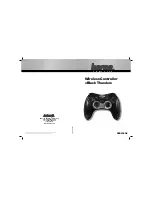
For instructions involving branches, such as jump or call instructions, two machine cycles are re-
quired to complete instruction execution. An extra cycle is required as the program takes one cy-
cle to first obtain the actual jump or call address and then another cycle to actually execute the
branch. The requirement for this extra cycle should be taken into account by programmers in tim-
ing sensitive applications
Program Counter
During program execution, the Program Counter is used to keep track of the address of the next in-
struction to be executed. It is automatically incremented by one each time an instruction is exe-
cuted except for instructions such as JMP or CALL that demand a jump to a non-consecutive
Program Memory address. For the A/D series of microcontrollers, note that the Program Counter
width varies with the Program Memory capacity depending upon which device is selected. How-
ever, it must be noted that only the lower 8 bits, known as the Program Counter Low Register, are
directly addressable by user.
When executing instructions requiring jumps to non-consecutive addresses such as a jump in-
struction, a subroutine call, interrupt or reset, etc., the microcontroller manages program control
by loading the required address into the Program Counter. For conditional skip instructions, once
the condition has been met, the next instruction, which has already been fetched during the pres-
ent instruction execution, is discarded and a dummy cycle takes its place while the correct instruc-
tion is obtained.
The lower byte of the Program Counter, known as the Program Counter Low register or PCL, is
available for program control and is a readable and writable register. By transferring data directly
into this register, a short program jump can be executed directly, however, as only this low byte is
available for manipulation, the jumps are limited to the present page of memory, that is 256 loca-
tions. When such program jumps are executed it should also be noted that a dummy cycle will be
inserted.
Note
The lower byte of the Program Counter is fully accessible under program control. The use of the
PCL might cause program branching, so an extra cycle is needed to pre-fetch. Further information
on the PCL register can be found in the Special Function Register section.
16
A/D Type MCU
F e t c h I n s t . 1
E x e c u t e I n s t . 1
F e t c h I n s t . 2
F l u s h P i p e l i n e
1
2
3
4
5
6
D E L A Y :
M O V A , [ 1 2 H ]
C A L L D E L A Y
C P L [ 1 2 H ]
:
:
N O P
E x e c u t e I n s t . 2
F e t c h I n s t . 3
F e t c h I n s t . 6
E x e c u t e I n s t . 6
F e t c h I n s t . 7
Summary of Contents for HT46R22
Page 7: ...vi A D Type MCU...
Page 9: ...viii A D Type MCU...
Page 10: ...P a r t I Microcontroller Profile Part I Microcontroller Profile 1...
Page 11: ...2 A D Type MCU...
Page 90: ...P a r t I I Programming Language Part II Programming Language 81...
Page 91: ...82 A D Type MCU...
Page 97: ...88 A D Type MCU...
Page 128: ...P a r t I I I Development Tools Part III Development Tools 119...
Page 129: ...120 A D Type MCU...
Page 140: ...Appendix Appendix 131...
Page 141: ...132 A D Type MCU...
Page 151: ...142 A D Type MCU...
Page 152: ...A p p e n d i x B Package Information Appendix B Package Information 143 B...
Page 161: ...A D Type MCU...
Page 162: ...Amendments...
















































